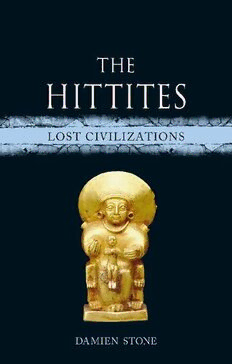Table Of ContentThe hittites
lost civilizations
The books in this series explore the rise and fall of the great civilizations
and peoples of the ancient world. Each book considers not only their
history but their art, culture and lasting legacy and asks why they remain
important and relevant in our world today.
Already published:
The Aztecs Frances F. Berdan
The Barbarians Peter Bogucki
Egypt Christina Riggs
The Etruscans Lucy Shipley
The Goths David M. Gwynn
The Greeks Philip Matyszak
The Hittites Damien Stone
The Inca Kevin Lane
The Indus Andrew Robinson
The Maya Megan E. O’Neil
Nubia Sarah M. Schellinger
The Persians Geoffrey Parker and Brenda Parker
The Phoenicians Vadim S. Jigoulov
The Sumerians Paul Collins
THE
HITTITES
LOST CIVILIZATIONS
Damien Stone
reaktion books
Published by Reaktion Books Ltd
Unit 32, Waterside
44–48 Wharf Road
London n1 7ux, uk
www.reaktionbooks.co.uk
First published 2023
Copyright © Damien Stone 2023
All rights reserved
No part of this publication may be reproduced, stored in a retrieval
system, or transmitted, in any form or by any means, electronic,
mechanical, photocopying, recording or otherwise, without the prior
permission of the publishers
Printed and bound in India by Replika Press Pvt. Ltd
A catalogue record for this book is available from the British Library
isbn 978 1 78914 684 4
Contents
Chronology 7
Prologue 15
1Rediscovering a Lost Civilization 18
2Political and Military History 27
3Via Diplomacy or War: Hittite
International Relations 54
4Major Sites of the Hittites 62
5Art and Material Culture 87
6Hittite Religion and Mythology 115
7Society and the Law 142
8Beyond the Bronze Age: A Continuing
Hittite Legacy 157
References 167
Bibliography 175
Acknowledgements 179
Photo Acknowledgements 181
Index 183
Chronology
c. 99660000––88000000 bc Circular groups of carved T-shaped pillars
are constructed at Göbekli Tepe (some of the
earliest known man-made structures). Th e site
has been dubbed ‘the world’s oldest temple’
c. 77440000––55220000 bc Occupation of settlement at Çatalhöyük −
one of the earliest villages in the world
c. 33550000––33000000 bc Writing is invented in Mesopotamia by the
Sumerians. Th e cuneiform script would later
be adopted by the Hittites
c. 2500 bbcc Great Sphinx of Giza is constructed for Khafre.
Representing Egyptian kings in this form
subsequently became a pharaonic tradition. Th e
mythical creature was adopted in the imagery
of many other cultures of the ancient Near East
and Mediterranean, including the Hittites
c. 22333344––22115544 bc Th e period of the world’s fi rst empire, the
Akkadians , founded by King Sargon the Great.
Documents from his reign attest to the earliest
mention of the Hattians in Anatolia. Th e language
of the Akkadians remained in use by the peoples
of Mesopotamia until around the start of the sixth
the Hittites
century bc. Akkadian became the language of
international diplomacy, used for communication
between major powers, including the Hittites
c. 21st– Merchants from Assyria operate trading
18th century bc colonies in Anatolia known as kārū. Th e most
notable of these was at Kültepe
c. 18th century bc Th e exploits of Pithana and his son Anitta are
documented in the fi rst known text composed
in the Hittite language
c. 1800 bc Earliest-known Old Babylonian version of
the Epic of Gilgamesh, a myth that enjoyed
popularity throughout the ancient Near East
c. 1650 bc Th e founding of the Hittite Old Kingdom.
Hattusa becomes the Hittite capital under King
Hattusili i
c. 1595 bc Th e Hittite king Mursili i sacks the city of Babylon,
bringing an end to the Old Babylonian empire
c. 1400 bc Beginning of the Hittite New Kingdom
c. 1360–1332 bc Th e Amarna letters attest an age of international
diplomacy between the powers of the ancient
Near East
c. 1350–1322 bc Th e kingdom becomes an empire during the
reign of Suppiluliuma i, regarded as the greatest
of the Hittite kings
1274 bc Th e Battle of Qadesh takes place between the
Egyptians (under Ramesses ii) and the Hittite
chronology
Empire (ruled by Muwatalli ii). It results in
a stalemate, leading to the drawing up of the
Egyptian−Hittite peace treaty some fi ft een
years later
c. 1250 bc Traditional date for the Trojan War, as given by
Herodotus
c. 1180 bc Destruction of Hattusa and the collapse of
the Hittite Empire. Several other states also
disappeared around this time, in what has
become known as the Bronze Age collapse
c. 1180–700 bc Traces of Hittite culture and the Luwian writing
system continue being used by the Neo-Hittite
(or Syro-Hittite) states
8th century bc Height of the Phrygian state in Anatolia, based
at their capital of Gordion. Th ere is a level of
Phrygian occupation at Hattusa, some fi ve
hundred years aft er the Hittite evacuation of
the site
c. 730–700 bc Hesiod composes the Th eogony, which describes
the origins of the ancient Greek gods. Th ere are
remarkable similarities between this work and
the much earlier Hurrio-Hittite Kumarbi cycle.
Traders were likely responsible for not only
exchanging goods between east and west, but
the sharing of such stories orally
546 bc Cyrus the Great conquers the Lydian king
Croesus, bringing Asia Minor under Persian
rule. Th e Lydians are credited with the
invention of coinage

